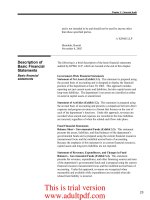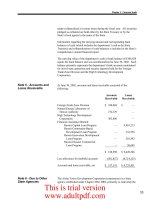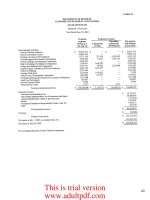Chapter 2: Lack of Planning and Fractured Management Undermine the State’s Tax Collection Efforts_part1 potx
Bạn đang xem bản rút gọn của tài liệu. Xem và tải ngay bản đầy đủ của tài liệu tại đây (380.26 KB, 11 trang )
5
Chapter 1: Introduction
efcient and effective use of state resources. Departments incorporate
their divisions’ and attached agencies’ individual budget proposals into
annual department operating and capital improvement project budgets
that are reviewed by the governor, then approved by the Legislature to
become law each year.
To support a given request, the department will include budget
justication tables. These tables provide line-item detail for personnel,
operations, equipment, and capital improvement expenses. Exhibit 1.3
details the Department of Taxation’s budget information by program ID
for scal years 2006 through 2010.
Exhibit 1.3
Department of Taxation Budget Information by Program ID, FY2006-FY2010
Appropriations
General Funds FY2006 FY2007 FY2008 FY2009 FY2010
TAX 102 Income Assessment
and Audit
$4,727,884 $4,757,096 $0 $0 $0
TAX 103 Tax Collections
Enforcement
$3,440,558 $3,628,186 $0 $0 $0
TAX 100 Taxation $0 $0 $9,357,395 $8,214,860 $8,870,813
TAX 105 Tax Services and
Processing
$5,655,764 $6,069,950 $8,275,362 $7,449,735 $6,428,501
TAX 107 Supporting
Services – Revenue
Collection
$7,849,807 $7,380,807 $7,720,809 $8,407,448 $6,876,905
Special Funds FY2006 FY2007 FY2008 FY2009 FY2010
TAX 107 Supporting
Services – Revenue
Collection
$452,000 $452,000 $452,000 $869,000 $452,000
Total Department Appropriations $22,126,013 $22,288,039 $25,805,566 $24,941,043 $22,628,219
Source: General and Supplemental Appropriations Act. FY2008 - TAX 102 and TAX 103 were consolidated into a new program ID:
TAX 100
This is trial version
www.adultpdf.com
6
Chapter 1: Introduction
The DoTAX follows the State Procurement Ofce’s guidance on the
State procurement process.
State procurement process and the Hawai‘i Public
Procurement Code
Statewide procurement is governed by the Hawai‘i Public Procurement
Code and the State Procurement Ofce (SPO). Together they provide
a central authority for procurement rules and procedures for all
governmental bodies in the State.
The Hawai‘i Public Procurement Code, Chapter 103D, Hawai‘i Revised
Statutes (HRS), was originally enacted in 1993 to promote economy,
efciency, and effectiveness in the procurement of goods, services, and
construction of public works for the State and counties. It applies to all
procurement contracts made by governmental bodies, unless specically
exempted. The procurement process is meant to foster broad-based
competition, providing best value to the State, and also ensure scal
integrity, responsibility, and efciency.
Chapter 103D, HRS, establishes the State Procurement Ofce, which is
administratively attached to the Department of Accounting and General
Services (DAGS). The SPO advises governmental bodies on the
procurement process and serves as the central point for the distribution of
procurement circulars, guidance, and directives to all jurisdictions. The
administrator of the SPO is the chief procurement ofcer (CPO) for the
executive branch. The CPO is responsible to perform a periodic review
of the procurement practices of all governmental bodies; assist, advise,
and guide in matters regarding procurement; develop and administer a
statewide procurement orientation and training program; and develop,
distribute, and maintain a procurement manual for state ofcials and a
guide for vendors.
Chief procurement ofcers are allowed to delegate any authority
conferred by Chapter 103D, HRS, to designees or to any department,
agency, or ofcial within their respective jurisdiction. The director of
taxation is the designated CPO for the Department of Taxation.
Chief procurement ofcers’ responsibilities for their respective
jurisdictions include: procuring or supervising the procurement of
goods, services, and construction; exercising general supervision and
control over all inventories; and establishing and maintaining programs
for the inspection, testing, and acceptance of goods, services, and
construction. In addition, the SPO administrator performs periodic
reviews of the procurement practices of all governmental bodies;
assists, advises, and guides in matters relating to procurement; develops
and administers a procurement orientation and training program; and
Department of Taxation
procurement structure
This is trial version
www.adultpdf.com
7
Chapter 1: Introduction
develops, distributes, and maintains a procurement manual for all state
procurement ofcials. Operational procedures consistent with the statute
and Hawai‘i Administrative Rules (HAR) may be adopted within each
jurisdiction to assist in the performance of these duties.
Procurement methods
The Hawai‘i Public Procurement Code establishes six procurement
methods available for governmental bodies. Two methods are
competitive sealed proposals and sole source procurement.
Competitive sealed proposals may be utilized to procure goods,
services, or construction when it is not practicable or advantageous
to the State to procure by competitive sealed bidding. Prior to the
preparation of the request for proposals (RFP), the chief procurement
ofcer will determine whether the ofcer or an evaluation committee will
evaluate the proposals. The evaluation factors set forth in the request
for proposals will serve as a basis for the committee to numerically rate
the submissions. A request for proposals will be issued with adequate
public notice to allow a sufcient number of proposers to participate.
Award will be made based on the ofcer’s or evaluation committee’s
recommendation for the proposal that is determined in writing to be the
most advantageous, taking into consideration price and the evaluation
factors as dened by the request.
Sole source procurement is awarded for goods, services, or construction
without competition when the chief procurement ofcer of a purchasing
agency determines in writing that there is only one vendor available.
Justication for a sole source must establish that the good, service, or
construction has a unique feature, characteristic, or capability essential
to the agency to accomplish its work and can be satised by only one
vendor.
Exemptions
Besides statutory exemptions that exclude applicability of the
procurement code, the code itself allows exemptions from certain
aspects of the above procurement methods. In some instances, while the
procurement for some goods and services are available from multiple
sources, it may not be practicable or advantageous to the State to procure
competitively. Either the procurement policy board determines by rules
or the SPO administrator determines in writing that a prior situation
exists to justify an exemption from the procurement code. While an
exemption may exist, governmental bodies are always encouraged to
adopt the spirit of the procurement code and use provisions of the code
and its own rules when procuring goods, services, or construction.
This is trial version
www.adultpdf.com
8
Chapter 1: Introduction
CGI Technologies and Solutions, Inc.
CGI Technologies and Solutions, Inc. (CGI) is an information technology
(IT) and business process services provider founded in 1976 in Quebec
City, Canada. Since that time the company has grown to include 26,000
employees operating in 107 ofces worldwide with 2009 revenues of
$3.8 billion. The company’s portfolio of services includes systems
integration and consulting, application management, technology
management, and business process services. In May 2004, CGI acquired
American Management Systems, Inc. (AMS), which doubled the size of
CGI in the United States. CGI and its predecessor AMS have been the
department’s IT vendor since 1999.
Department of Taxation performance-based contracts
In Act 218, SLH 1995, the Legislature appropriated $2,540,046 in
general funds for the design of a new Integrated Tax Information
Management (ITIM) system. The DoTAX’s old Comprehensive Net
Income Tax system, which was prone to failure, would have been unable
to process income tax returns at the turn of the century and keep pace
with changing requirements.
The Legislature also became aware that the DoTAX would have been
unable to implement tax law changes rapidly without adversely affecting
its processing of tax returns. In addition, the scal crisis during the mid-
1990s focused attention on raising revenue more efciently, including the
use of automated systems.
In 1996, through Act 273 the Legislature authorized DoTAX to enter
into performance-based contracts with a private vendor for its System
Replacement Project. Act 273 denes a performance-based contract as:
A contract under which compensation to the vendor shall be
computed according to performance standards established by the
department. Any performance-based contract entered into by the
department for such purpose shall provide:
1. For the payment of fees based on a contractually specied
amount of the increase in the amount of taxes, interests, and
penalties collected and attributable to the implementation of
automated tax systems; or
2. For the payment of fees on a xed-fee contract basis to be paid
from the increase in the amount of taxes, interest, and penalties
collected and attributable to the implementation of automated tax
systems.
This is trial version
www.adultpdf.com
9
Chapter 1: Introduction
In 1999, DoTAX commenced the ve-year ITIM system project to
replace its aging computer systems for income and business taxes and
to “re-engineer” the organization to become more efcient and effective
in accomplishing its mission. Using the competitive sealed proposal
procurement method, the department entered into a performance-based
contract in August 1999 for the ITIM system with CGI (formerly
AMS). The total contract price was about $51 million. To pay for the
system, the 1999 Legislature established the Integrated Tax Information
Management Systems Special Fund, which consisted of general excise
tax revenues. The fund had a July 1, 2005 sunset date.
Since then, there have been numerous supplemental agreements,
contracts, and memorandums of understanding for enhancements,
modications, and product support through 2007. The total contracted
price to CGI for these supplements and modications was approximately
$10.8 million, bringing CGI’s total compensation for ITIM system from
inception to 2007 to about $62 million.
Delinquent Tax Collection project
In 2008, the DoTAX entered into a benets-based (contingency fee)
contract with CGI for the Delinquent Tax Collection project. This sole
source award was executed in January 2008 with a contract price of $25
million and subsequently amended in June 2009. The contract provides
for payment to CGI at a compensation rate of 33.3 percent of all new
collections realized until the maximum amount of $25 million has been
paid.
The Delinquent Tax Collection project’s three main objectives are to:
1) encourage taxpayers to timely le their tax returns and pay the tax
owed; 2) enhance the department’s ability to collect taxes legally owed to
the State; and 3) clear the business account registration rolls of accounts
that are no longer active by encouraging taxpayers to cancel unneeded
accounts.
The rst phase of the project involved the Registered Business Non-
ler project, beginning with the General Excise Tax Non-Filer project
component in June 2008. This component focused on general excise
tax licensees who had not led general excise tax returns for tax years
2001 through 2007. The initial phase of the Withholding Tax Non-Filer
Initiative commenced in November 2009 for withholding tax returns for
tax years 2001 through 2008. As of June 2010, gross collections for the
non-ler project exceeded $75 million—less than 1 percent of the total
state tax collections of $10.5 billion for the same period—allowing CGI
to be paid the maximum contract amount of $25 million.
Integrated Tax
Information
Management system
This is trial version
www.adultpdf.com
10
Chapter 1: Introduction
Hawaii Government Employees Association prohibited
practice complaint
In June 2009, the Hawaii Government Employees Association (HGEA)
led a prohibited practice complaint against the department, alleging the
department had privatized computer and computerized tax services to
an outside vendor, CGI, in violation of Sections 89-13(a)(5) and 89-9,
HRS. This provision prohibits a public employer from entering into
private contracts for jobs customarily and traditionally performed by
civil service employees without rst bargaining with the employees’
representative. The association represents certain DoTAX employees.
The allegations include CGI’s employment of “dozens of analysts,
programmers, and testers, who are paid $200/hour, while state employees
continue to conduct work for which CGI continues to be paid.”
Our ofce, in conjunction with CPA rms that we contracted with, has
conducted four nancial audits of the Department of Taxation to examine
the department’s nancial records and its systems of accounting and
internal controls and tested these for compliance with applicable laws
and regulations. These are Report Nos. 75-5, 85-3, 94-20, and 96-9.
Examination of the nancial statements was performed by the CPA
rms. In general, the CPA rms found that the statements, except for the
general xed assets account group (which was not included in the terms
of their engagement) presented fairly in all material respects the nancial
position of the department for the years audited.
In Report No. 75-5, Financial Audit of the Department of Taxation, we
found a lack of sufcient controls over tax payments made in several
areas, inequities in the real property tax assessment, and inefciencies
in refunding overpayments of income tax to taxpayers as well as in the
examination of income tax returns. We recommended the establishment
of accounting controls in certain areas, taking steps to review, adjust,
and establish denitive policies and guidelines for real property tax
assessments, and discontinuing the department’s practice of examining
every tax return that shows an overpayment of taxes before refunding the
overpayment to the taxpayer.
In Report No. 85-3, Financial Audit of the Department of Taxation, we
found that the department’s staff was relying on incomplete records of
authoritative information in the administration of the general excise
tax law. Also, the department was not providing sufcient public
information to assist the taxpayer in complying with the tax law or to
ensure the uniform application of the tax among taxpayers. Our audit
found that the department had failed to correct several of the conditions
noted in our 1975 audit. We recommended that the department centralize
the compilation and maintenance of all authoritative information, classify
Prior audits
This is trial version
www.adultpdf.com
11
Chapter 1: Introduction
its ofcial position with respect to various statements and releases, and
reissue past publications of General Excise Tax Memorandums and
information bulletins to eliminate any confusion regarding authoritative
source. We also recommended that the department establish accounting
controls over all mailed-in tax payments, review its security measures to
protect valuable records, documents, and les from destruction by re,
and establish a random audit selection process and maintain statistics on
the outcomes and characteristics of the taxpayer.
In Report No. 94-20, Financial Audit of the Department of Taxation,
we found that although the department had implemented most of the
recommendations made in our 1985 report, it did not consider the use of
a depository system to reduce delays in depositing receipts. In addition,
we found that the department could improve its ability to collect taxes
by strengthening its internal control and administrative practices and
resources. Specic to the department’s Comprehensive Net Income Tax
(CNIT) system, which processes and accumulates income tax return
information, our audit found inefciencies that prevent the department
from efciently comparing data among the different computerized tax
systems or compiling data from the CNIT system based on key attributes.
We recommended that the department re-program its computer system to
identify taxpayers who have not led the required tax returns, document
the approvals obtained for the payment plans of delinquent taxpayers,
and re-examine its practices of not initiating foreclosure proceedings on
delinquent taxpayers.
Finally, Report No. 96-9, Follow-Up Audit of the Department of
Taxation, was conducted by our ofce as a follow up to the 1994 audit.
We found that the department had taken positive steps to implement
the recommendations of the 1994 report and also initiated additional
actions to improve tax collections and enforce compliance. The
department, however, was not able to ll vacant positions in its audit and
collection divisions due to budget restrictions. We recommended that
the department continue to follow its new collection procedures and to
implement its new computer system.
Assess the adequacy of the Department of Taxation’s strategic 1.
planning for and procurement of its IT systems/projects.
Assess the adequacy of the department’s management of its CGI 2.
contracts.
Make recommendations as appropriate.3.
Objectives of the
Audit
This is trial version
www.adultpdf.com
12
Chapter 1: Introduction
As requested by the 2010 Legislature in SCR 78, SD 1, our management
and nancial audit focused on the contracts between the DoTAX, CGI,
and CGI’s predecessor AMS, for the period ending June 2010. We
included prior years from 1999, the inception of the rst contract with
AMS, as deemed necessary. We conducted interviews with selected
administrators, managers, and staff in the DoTAX, CGI, as well as the
Ofce of the Governor, and other agencies, organizations, community
groups, and individuals as required. Our audit included a review of
policies and procedures, letters, emails, reports, and other relevant
documents and records to assess and evaluate management’s compliance
with statewide procurement policies and procedures and other pertinent
laws, rules and regulations, and policies and procedures.
We tested a sample of relevant documents and reports, reviewing
specically for compliance with applicable provisions of contractual
obligations, state procurement laws, rules, policies and procedures,
as well as with the DoTAX’s own internally prepared policies and
procedures. We altered our testing procedures, however, because of
constraints placed on our access to both department documents and staff
by the director of taxation.
Auditor’s authority to access information
The Ofce of the Auditor has broad authority to access information.
Section 23-5, HRS, gives the Auditor authority to examine and inspect all
accounts, books, records, les, papers, and documents and all nancial
affairs of every department, ofce, agency, and political subdivision.
Further, Section 92F-19, HRS, of the Uniform Information Practices
Act, requires agencies to share records with the Ofce of the Auditor.
The administration’s withholding of records from our ofce during
this audit is in contravention to the law and prevents the Auditor from
carrying out her constitutional and statutory audit authority. We nd the
administration’s efforts to stymie our audit contrary to the Legislature’s
directive in provision SCR 78, SD 1, to cooperate with the audit to the
fullest extent possible.
Auditor’s access to information
At the onset of our audit we requested department information,
documents, and electronic mail. A request for documents is standard
procedure during the preliminary planning phase and eldwork of an
audit. Our rst request for documents to the department was on June 1,
2010, with the nal delivery of documents and information from this rst
request received four months later on October 18, 2010.
Scope and
Methodology
This is trial version
www.adultpdf.com
13
Chapter 1: Introduction
Our rst request for department electronic mail to the Department of
Accounting and General Services was made on June 29, 2010. The
comptroller replied on July 8, 2010 that he was conferring with the
affected parties and would provide a more complete response thereafter.
On July 21, 2010, at the request of the comptroller, we rescoped our
request to key words and individuals due to the volume of email accounts
from our original request. On July 27, 2010, the comptroller responded
that his ofce was beginning a search of all affected email accounts
and would make every effort to produce the requested documents given
personnel reductions, limited resources, and the need to coordinate with
other affected agencies and the Department of the Attorney General. On
September 10, 2010, we received the rst production of emails requested
from the Department of the Attorney General, which consisted of a
single, two-page email. On November 10, 2010, four months after our
initial request, we received the nal email production.
Further, the current DoTAX director has taken an active role in our audit,
which is unique and unprecedented and has hindered our audit work.
We were told that due to condentiality privileges relating to taxpayer
communications, all requested documents must rst be collected,
screened, and culled by the department, with a nal review by the
director. According to the director, the review was intended to remove
any condential taxpayer information. We nd this unnecessary given
that the Internal Revenue Service allows inspection of returns and return
information by state audit agencies charged under the laws of the State to
audit state revenues and programs.
We were also restricted access to various DoTAX work areas that
could have put us in contact with taxpayer information. As a result,
we were required to request department documents rather than pull the
information ourselves and interact with staff directly. According to
the director, our request for documents resulted in more work for the
department staff. We reiterate that there would have been no impact to
the department’s workload had we been allowed to conduct our audit
according to our routine procedures and protocols.
Records disclosure
Requested documents and emails have been screened and released
piecemeal to us over an extended period of time, from June 2010 through
November 2010. We were also told by a deputy attorney general that
several tax division attorneys had been screening the documents twice
for subject matter relevance and attorney-client and executive privileged
information, a unique and time-consuming process.
This is trial version
www.adultpdf.com
14
Chapter 1: Introduction
Audit interviews
The department also interceded in our audit interviews of current
DoTAX employees. We were told that the director required employees
whom we interview to notify their division administrators and ofce
chiefs. Employees and division and ofce chiefs who did not comply
were routinely reprimanded by the director. In addition, any documents
discussed in the interview and requested by us were collected, screened,
and culled by the department, with a nal review by the director prior
to release to our ofce. Overall, the overt efforts by the department to
control and stall our audit were unprecedented, delayed our work, and
compromised our audit process.
Audit standards
Our audit was conducted from June 2010 through November 2010
pursuant to Section 23-4, Hawai‘i Revised Statutes, which requires the
Auditor to conduct post audits of the transactions, accounts, programs,
and performance of all departments, ofces, and agencies of the State
and its political subdivisions; and according to generally accepted
government auditing standards and the Ofce of the Auditor’s Manual
of Guides. These standards require that we plan and perform the audit to
obtain sufcient, appropriate evidence to provide a reasonable basis for
our ndings and conclusions based on our audit objectives. We believe
that the evidence obtained provides a reasonable basis for our ndings
and conclusions based on our audit objectives.
This is trial version
www.adultpdf.com
15
Chapter 2
Lack of Planning and Fractured Management
Undermine the State’s Tax Collection Efforts
In 1999, the Department of Taxation (DoTAX) began an effort to
replace its aging computer system, which had become increasingly
unable to process income tax returns and fulll the growing needs of
Hawai‘i’s tax system. The department contracted with an IT vendor
to develop and install a new, integrated tax information management
system; however, ten years and $87 million later, with IT contracts still
on-going, the system has yet to be nalized. A lack of planning by
department leaders has allowed the vendor to become an essential and
entrenched component in the department’s IT infrastructure. In addition,
ill-equipped project managers contributed to poor contract oversight and
weak vendor accountability.
Focused mainly on revenue collection, the department took on too many
projects with insufcient stafng and budget resources. As a result,
the department’s IT systems may not be sustainable without continued
support from the vendor, which is scheduled to terminate services in June
2011. Also, when its director leaves in December 2010, the department
will be anchored by a management team rife with internal conict.
Without a transition plan in place, DoTAX and its IT infrastructure face a
precarious future.
The Department of Taxation’s poor IT project management led to a 1.
contract that is not in the best interest of the State.
The department’s failure to develop and implement an effective 2.
strategic plan threatens the sustainability of its IT infrastructure.
The department’s performance as the tax collection arm of the State
has been hampered by its inability to effectively manage its IT systems
contracts. Poor leadership and internal management strife along with
minimal project management and training has resulted in weak IT
contract accountability. In addition, oversight of key IT contracts was
left to managers with no formal project management or IT background.
The department subsequently failed to follow through on contract project
management provisions. As a result, the department cannot accurately
Summary of
Findings
The Department’s
Poor IT Project
Management Led
to a Contract That
Is Not in the Best
Interest of the
State
This is trial version
www.adultpdf.com









